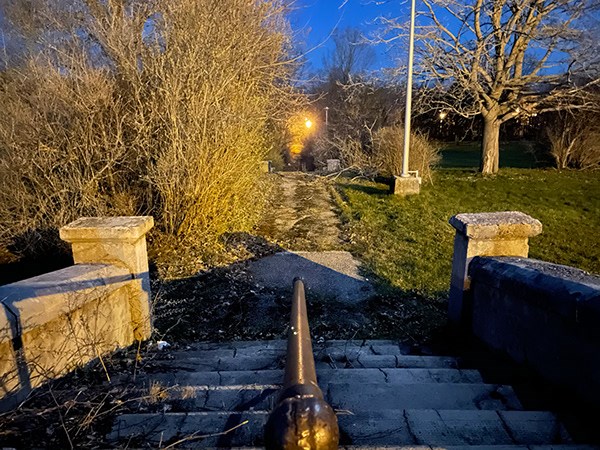The old adage that a picture is worth a thousand words still rings true.
That is evident in the work of Orillia’s Melanie Leon, a Lakehead University student who used a series of photographs to tell the ‘impossible story’ of the Huronia Regional Centre (HRC).
The long-shuttered institution on the edge of town has a long and tangled history - something Leon did not know much about.
In fact, her professor asked her to go out to the sprawling property on Memorial Avenue to take photos before investigating the facility’s heritage.
So, last month, on a cool spring evening, she did just that. With the help of her dad, Peter Leon, a retired OPP officer, she walked around the site with her iPhone 12 Pro and took several dozen photographs as night fell.
It was, she says, an eye-opening experience.
“I let my inner conscience guide me to particular spots where I took photographs, experimenting with different angles, digital zoom settings, portrait mode, and night mode,” Leon explained.
“From the moment I stepped out of the car, it felt eerie, and as it grew darker, I felt an inexplicable presence and haunting both at the site and at the cemetery,” said the 19-year-old Orillian.
Leon, who just completed her second year in the Interdisciplinary Studies program at the Orillia campus of Lakehead, said her role as a “researcher and photographer in the photography project was not to fill in the gaps or provide answers to this impossible story, but rather, to bring light to many of these broken parts, to display the emotion, loss, and to illuminate the haunting.”
And it was haunting, she said.
“Starting at the steps that lead up from Lake Simcoe to the Administration building, and ending at the cemetery, you will see that there is not always a definite story to each photograph, but that an inexplicable presence is imminent within all (the) photographs,” she explained.
Leon said that while “there is a story about the Huronia Regional Centre ... there are also a lot of broken parts that may never be pieced together.”
The photos in this photo essay have not been adjusted in any way.
“I have left all the photographs in the state that they were originally taken because in my opinion … the discomfort, loss and haunting is expressed without the need to change the colour or edit them,” she explained.
Once she took the photos and toured the site, she was challenged to look into the history of an institution that helped define Orillia for generations.
In her report, she traced the roots of the facility to its predecessor at what is now Couchiching Beach Park and how it evolved into the Hospital for Idiots and Imbeciles in 1877 on Memorial Avenue, expanding to a 151-acre site on the shores of Lake Simcoe, before it grew rapidly into a self-sufficient institution with a number of buildings for residents, staff and nurses, with a farm, barn for animals pump house, and an indoor pool.
It was renamed the Huronia Regional Centre in 1974, she notes, and references some of the inhumane conditions and treatments that occurred there over the years.
In her report, she notes the buildings were decommissioned on March 31, 2009.
“With the official closure, the government promised to end the era of institutionalized care for people with developmental disabilities,” she explains.
Most of the buildings remain vacant, but what was once the farm is now the Ontario Provincial Police Headquarters, Cottage C is used as a courthouse and Cottage O is used as the OPP Academy.
The cemetery, on the west side of Memorial Avenue, is an important part of the HRC story, she notes.
Prior to 1958, gravestones were only marked with the registration number of the resident, but after 1958 all gravestones were marked with the resident’s name, year of birth and year of death. The last institutional burial was in 1971.
“Survivors desired to create their own memorial, so with money left over from the Huronia Regional Centre class action settlement, survivors worked with sculptor Hilary Clark Cole, designing a monument that reflects the experiences of the institution and it was unveiled on Aug. 24, 2019,” Leon notes.
Click here to read her project report.
